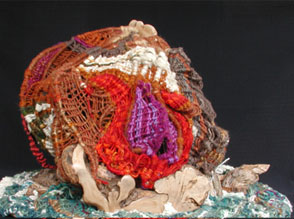| Odyssey | Spirit Caves | Mom's Bones | Tikkun Olam | Weaving | Totems |
Circe's Palace on Aiaia
 - Version 2.jpg)
15"h x 21"w x 25"d
Eucalyptus, wire fiber, ficus, plastic pigs, varnish, birch
Still in shock and mourning after the loss of all their companions in eleven of the twelve ships under the command of Odysseus, the crew of Odysseus’s one remaining ship enters another unknown port. For two days the crew sits weeping. Even Odysseus is disoriented. He has no idea where they have landed or which direction is home and his men are in no shape to go exploring so he climbs a crag near the harbor.
He sees smoke rising in the distance. Curious, he prepares to check out who lives there, but then catches himself. His men are undone. They need him. He decides to return to the ship, take care of his men, and then send a few of them to scout. On his way back, a huge stag crosses his path. Odysseus feels blessed by this offering. He kills the stag, and carries it to the ship. All day the crew members feast and sleep. Next morning, Odysseus reveals his plan. The crew members burst into tears again, so he splits them into two platoons, one he will lead, and the other to be led by Eurylochus, a companion he trusts. They draw lots. Eurylochus with his 22 comrades wins. Still weeping, he and his small platoon set off.
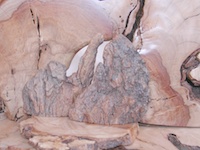
They arrive at an estate where ferocious wild animals fawn like dogs. The men cringe, suspecting something is amiss. From within the palace, they hear the voice of a woman singing inside in time to shuttle and loom. “Goddess or woman?” they wonder.
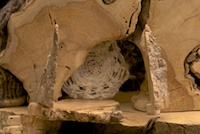
Circe opens her gleaming doors and invites them in. All but Eurylochus follow. She mixes a potion and adds drugs. When her guests have emptied the drinking bowls and are in her thrall, she strikes them with her wand and drives them into her pigsties. There she transforms their hair to bristles, their noses to long snouts, and their lithe bodies to hefty porkers -- though their minds remain human. Eurylochus waits outside. When no one emerges, he hurries back to the ship. Odysseus suggests they return together to the palace. Eurylochus begs Odysseus to cast off and sail away before they all disappear. Having already lost so many, Odysseus refuses to abandon any more of his crew.
.jpg)
.jpg)
 - Version 2 (1).jpg)
He reassigns Eurylochus to take care of the ship and the remaining men, then sets off alone to retrieve the lost crew members. He meets the messenger god, Hermes, sent by the gods to help.
 - Version 2.jpg)
Hermes gives instructions on how to approach Circe and offers a holy plant, moly, with white blossom and black root, which will protect Odysseus from Circe’s charms. Inside, he drinks the proffered potion like a good guest. Protected from her spell, when Circe raises her wand, Odysseus draws his sword and threatens to run her through. Circe knows then who he is, from her own prior discussions with Hermes, and invites him to bed. “Only if you swear an oath that when I lie naked with you, I will not be unmanned,” Odysseus demands.
She promises, he mounts her swinging bed…. Through continuing negotiations, he gains the captives’ metamorphosis back to human form, their release from captivity, and directions home – alas, via the Land of the Dead.
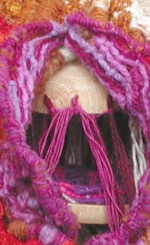
.jpg)
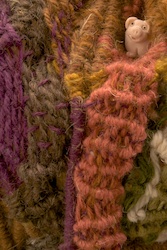
After a year of R&R in Circe's realm (reminiscent of the fairy tales of many cultures, where mortals entering another realm are enticed to remain a year and a day), the men remind Odysseus of his mission, to go home. Circe, a daughter of the Sun, provisions their ship for the next leg of their journey. a trip to the Underworld, where the sun never shines. On their last night, Elpenor, a young crew member, drunk from the festivities, climbs a ladder to the rooftop where he falls asleep. Morning muster wakes him, but forgetting where he is, he rises and falls off the roof to his death. No one notices.
Circe describes in detail for Odysseus the labyrinthine journey to the Underworld, the intersections of astonishing rivers, where he must go, what he must do, who among the dead must speak with him, the soul of Teiresias the blind prophet from Thebes, most of all, as he of all the dead has retained foresight and can see the future, Odysseus's way home.
Circe by now is clearly an ally. Yet she seems also an instructive priestess. She takes on the responsibility for mentoring Odysseus in the Mysteries of Death. She teaches him the necessary rituals of evoking the spirits of the dead, prepares him to listen when approached for a burial, and the importance of the ceremonies of remembrance. She also instructs him on gratitude, describing how on his return home, he must make a memorial sacrifice for all who have perished, and particularly for Teiresias, for his guidance home.
She helps provision the ship with the offerings the sailors will need when they visit Hades, where Teiresias will prepare Odysseus for the lurking challenges, risks and enchantments he and the crew have yet to survive – or not, on the way home: the Sirens, Scylla, Charybdis and the Clashing Rocks, and the fateful island of Helios, the Sun.
Circe fully expects the crew to stop by her place on their way back from Hades, if they survive the Underworld journey. Elpenor, their forgotten dead companion, convinces them to do so. Elpenor is among those souls to speak in the Underworld, imploring the Greeks to bury him properly. On their return to Circe's realm, the crew honors him as he asks, planting on his grave his oar, which he had plied so bravely with his companions. Odysseus and his remaining crew, in so returning from the Underworld, are marked men, as Circe notes, men who will have "died twice," unlike most other mortals, for Odysseus and the crew on that leg of the voyage will have already died once, having entered the Land of the Dead, though still alive. Before they leave Circe's realm again, Circe provisions the ship again, this time with what the crew will face on the dangerous journey ahead.
Yet, before we leave this section, it is worth mentioning that the detail of planting of the oar of the fallen Elpeno, builds on the instructions of Teiresias to Odysseus about the last journey of Odysseus, to be undertaken when he returns home. As will be described more fully with the Hades sculpture, Teiresias tells Odysseus that his return home from Troy is not the end of his travels. When he has accomplished the necessary peacekeeping and sacred duties, cleansing rituals, sacrifices, etc. at home, Odysseus must shoulder his own oar, travel inland to communities so foreign to his way of life that they do not even know what an oar is. There he must tell his story, speak about the sea, its god, and his own Odyssey. What interests me narratively in this passage is how the oar of Elpenor lays the ground for Odysseus later to shoulder his own oar. A new oar, we gather, since by the time Odysseus arrives home he will have long ago lost his own oar and the rudder/oar by which he steered his ship on this journey. And what did that new ritual oar look like? I wonder.
The Truia, or Trojan Labyrinth
As readers of this section of the Odyssey, we get a sense that the approaching loop around the Underworld and back to Circe's place is yet another pivot event: the departure from Troy, the first, for the eventual return to home; the second, Odysseus falling asleep not far from home, and shot back to Aiolos, the god of the winds; third, the Underworld, with backtracking via Circe's realm, and finally the desecration of the sacred cattle of the Sun, still ahead, resulting in the destruction of the last ship and its crew, and the torturous journey of Odysseus alone back through the horrid pass where Charybdis and her cohort of horrors wait. These pivot points seem to me somehow central to the spiritual topography of the journey.
In my descriptions of the Odyssey on this website, I try to make sure I have the details of the story correct. Yet I also have my own tangents, or threads of story that nag at me, evoked by how the stories strike me, personally. It is said of the ancient Underworld, that the river Styx spirals round it nine times. It calls to mind for me the structure of a labyrinth, a round about way of getting there. There is an old pattern for the geometrical Truia, or Trojan labyrinth, with four pivot points and five intersects. I learned about this "iconic formula" in a course on "Writing the Invisible," given at a writing conference by Eleanor Kokar Ott. Later in this website update process, I will try to create a section on how the four squared-off "pivot points" and the five intersects are connected to create the pattern of the Truia as It is an interesting code and a fascinating form. Below are the beginning nine marks and the Truia that joining them correctly creates.

.jpg)
I often use the Truia pattern as a centering exercise. I place the nine symbols on a paper, join them up, either clockwise or widdershins, into the Truia, and with the question in my mind, "What would you have me know?" I trace with my finger the path created. I enter the labyrinth I have drawn, continue to the center, return to the entry and take what has come to me on that mini-journey into my day. Today, as I prepare this write-up for the website, is the first time I have recognized the Underworld as a pivot, indeed as one of the four pivots I have so far recognized within the Odyssey. So for the first time, with sufficient detail, I am exploring this possible connection betwen what my former research suggests is a medieval design, the Truia, may also be a coded map for the Odyssean journey to Troy, so long before. Living with this text continues to be for me a voyage of discovery. (Of course, I could be taking a wrong turn in connecting the Truia with the events of Homer's Odyssey, but then, maybe I'm right on course!)
Construction details
The Circe sculpture was the fourth sculpture I attempted, once I realized the size of what I was doing – what I was caught up in. I include a series of photos showing the initial setting of the pieces> I begin with a few close-ups showing the amazing figures that appear within the wood, that guided me to choose the piece to the left below for the vertical front of Circe's palace. Note the upturned face with the big nose. Can you hear a cackly laugh? These hag-like markings add to the fairytale quality of the Circe episode, bringing to mind the child-tales of Hansel and Gretel, and a favorite at our house when our boys were young, The House that Stood on Chicken Legs. the hag below has a little messenger hovering about where an ear should be. Can you see it? These forms, witihin the wood itself fascinate and guide me in the creative choices I make. I could not resist incorporating the three sensual, evocative acorns in the frontal design (especially as acorns are also used as pig-feed!), and the pig-foot hovved, spiral stairs leading up to Circe's entry way were too tempting to resist!
.jpg)
.jpg)
.jpg)
Below you can see the layout of the wooden pieces as I begin the base of the sculpture. To the right, you can see how I place the front wall of Circe's Palace. Once I have the places set -- sometimes the pieces simply will not "set" and I can spend hours rearranging until the pieces finally "consent" and come to rest! The photo to the left below this pair is of me attaching the hinges for the doors. Oddly, the burls I chose look like the ceremonail headgear of the pharoahs of the Upper and Lower Nile. I go with it! Then the wooden pieces get their finishing sanding and varnishing. Further below is a photo of the wire armatures added behind the vertical frontal piece, the beginning of the weaving process, and then different views of the exterior side and back.
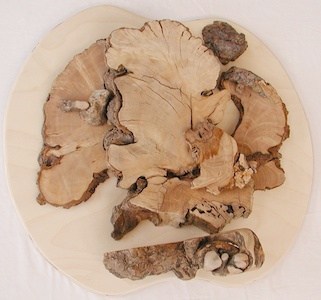
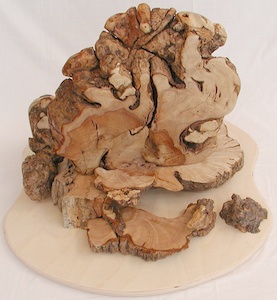
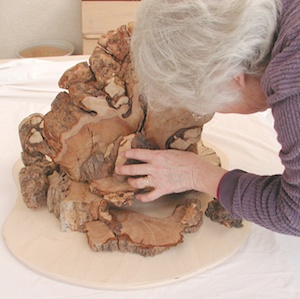
Creating a single sculpture can sometimes take a month or more, depending on what else is happening in my life, how many steps are involved in preparing the pieces, and how elaborate the fiber sculpting, with its many colors, textures, and techniques. During the time I am working on the sculpture, the themes play in my mind. Circe, for instance, strikes me as the sort of character Fellini might draw on, when considering the emergence of the Feminine in a movie like Juliet of the Spirits. So although in the text, Circe's palace is described as white, in this sculpture, Circe, so like that ancient goddess-priest known as "Mistress of Wild Creatures," the "potnia theron," on ancient cylinder seals, inhabits in my imagination, a wildly colorful inner environment, as you can see in the sculptures wiithin the "Discovering the Sacred Feminine," below.
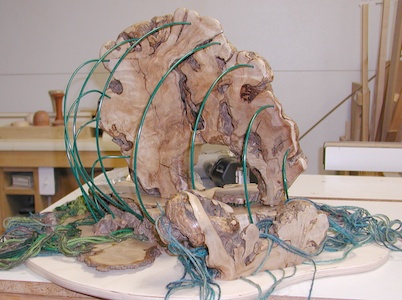
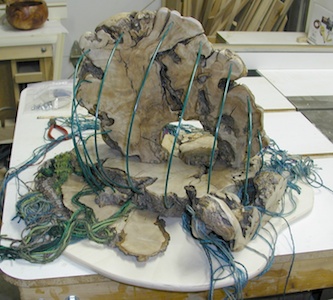
As for the pigs that show up in sculptures above: Since I moved to a rural setting on Whidbey Island, I often head off to the various hardware stores for my projects. As my Odyssey projects continued to develop, even after some of the sculptures appeared to be finished, I noted more intently the animal elements in the theme, and a while later, I realized that each hardware store on the island had its own special a selection of miniature farm animals. Some time after finishing this sculpture (or so I thought! These sculptures seem to have a timetable all their own!), I encountered a tiny pig with character in the collection at one store, a sense of humor, I thought, then another with interesting markings, on my hardware store rounds, and so it happened that this sculpture gradually became "peopled" with pigs! Though in some of the other sculptures, I have created the animals myself, as old Argos, the aged, faithful dog of Odysseus, from clay, or the golden immortal dogs of Alcinoos among the Phaeacians from clay covered with gold leaf, I have also picked up little creatures on my travels, tiny coy crockery sheep for the Homecoming, an Iona-made Highland cow as a model for the cattle of Helios, geese for a dream scene, and I have shamelessly incorporated them into these sculptures where it adds to the themes!
Discovering the Sacred Feminine
Thinking about the interior design of Circe's palace and how exactly she might have slept with Odysseus, with her household staff and the pigs everywhichwhere, entered a new realm within this story, the intimate interior. I was moved to create a veiled circula bed for Circe and to suspend it from the high ceiling within the palace, like a swing, with its own shutter-able opening to the world. Creating the shutters was itself an exotic imagining! Hover there!
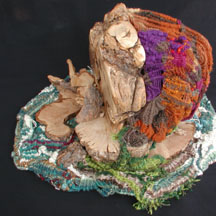
Circe's Palace, view from above
I have met in my life women who in the presence of powerful men change utterly, as if they had suddenly grown pseudopod-like sexual parts that descent to the ground like a third leg trailing behind them, a cross between a wedding train and the slick opalescent slime wake of a northwest banana-slug on the move. I have also met men who are "armed and ready" from the moment they encounter such a seductive female. Not everyone, however, has a Hermes to warn them in advance or to provide the necessary accoutrements for taming, or even surviving, what might happen next!
The powerful, predatory aspect of Circe is also reflected in the form of the weaving hanging within her doorway, like a spider's web. Clearly these are my imaginings, and reflect my discoveries, within the text, of an emergent subtext of the Sacred Feminine --- as in Erich Neumann's psychoanalytic compilation, The Great Mother, the good and the bad, the dark and the bright, the loving and the consuming raw. The Feminine is essential in this old hero story!
With this discovery and the association to intimacy, to beds, came a whole new aspect to the creations. I found myself returning to the Cave of Calypso, the piece I created just prior to the Circe sculpture, and adding to the cold cave a small woven sleeping "igloo," in soft pastel pinks, mauves, and greens. Similarly in the Homecoming, the bed-tower of the only child, Telemachus, the child peacock, and the secret, rooted olive bed carved by Odysseus. In a later creation, that of the Phaeacian city on Scheria, the sleeping quarters of the king and queen, their daughter and son receive attention (more round beds!), with Nature-painted ripply shells for roofs, precursors to the modern use of corrugated plastic! "Dwelling with Intimacy" could become an additional study in its own right, with perhaps a companion piece to Shrouds and Shileds. For now, I will try to include photos of the intimate spaces withiin each relevant sculpture.
